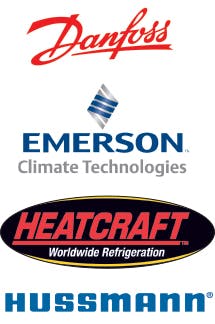Refrigeration Gas Phaseouts Bring Indigestion
The refrigeration industry took a hard blow to the head since my last Roundtable article appeared in our August issue.
In July, the Environmental Protection Agency (EPA) issued a new Notice of Public Rule (NOPR) that will seek to delist some refrigerants commonly used in supermarkets, condensing units and commercial refrigeration equipment. Companies such as Emerson Climate Technologies immediately went to work with industry organizations to draft comments to the proposal in an attempt to temper the EPA’s action, which would put some favorite gasses out to pasture.
From the end user’s point of view, in trying to lower their total cost of ownership, contractors are trying to have refrigerant last as long as possible without having having to retrofit in another three years, when the EPA will say ‘the next platform is 600 GWP.'"— André Patenaude
The proposed EPA rule is part of the Significant New Alternatives Policy (SNAP) and works in conjunction with President Obama’s Climate Action Plan to reduce the use of hydrofluorocarbons (HFC) with high global warming potential (GWP). While currently in the comment period, if passed, the rule would ban R-404A, R-507A and R-134a in specific new and retrofit applications by January 1, 2016.
Others included are R-407B HFC-227ea, R-407B, R-421B, R-422A, R-422C, R-422D, R-428A, and R-434A.
Needless to say, but I'll say it anyway, this was a natural first topic for our annual Refrigeration Roundtable forum, held each year during Comfortech. Our panelists of supermarket executives with insight into mechanical systems and procurement, and leading refrigeration contractors, were ready with answers to many questions on refrigerant phaseouts and other issues.
Q: What are your thoughts on this latest EPA ruling? 2016 puts industry’s search for alternatives on a very short time frame.
• Sam Wilson, president, Advanced Refrigeration Systems, Sacramento, CA said any phaseout plan is difficult, because once announced, refrigerant prices start to fluctuate, and customers don’t want to change to new systems because of the high first cost.
“They seem to keep changing the game as it goes along. I think if we knew ahead of time what it was going to be, we could plan for it and get it done.“ — Sam Wilson
“Even with the price of R-22 expected to skyrocket, a lot of customers are waiting, but we keep encouraging them to change. It would be nice if the EPA was a little more clear, a couple of years ahead of time, and say exactly what each phaseout will entail,” Wilson said. “They seem to keep changing the game as it goes along. I think if we knew ahead of time what it was going to be, we could plan for it and get it done.“
• Joe Matthews, founder and president/CEO, 5-Star Refrigeration & Air Conditioning, Brooksville, FL, has had a hard enough time finding qualified technicians for his ever-expanding business. Refrigerant changes always add a few rocks and ledges to the mountain he and other contractors must climb every day, month, and year.
“We’re still working on conversions of R-22, or really haven’t started yet. The big players, such as Publix and Walmart in our region are just starting that process. It’s complicated, and the problem I see is not having the workforce to complete it. We’re talking years of strategy to get it right,” he said.
• André Patenaude, director of CO2 business development for Emerson Climate Technologies (co-sponsor) explained the EPA’s ruling amounts to a four-year acceleration.
“The EPA is accelerating F-gas regulations by four years. That’s the problem. They’re looking at R-404A, 5057 — actually, anything that has a Global Warming Potential (GWP) of 2,500 or higher, starting in the year 2020,” Patenaude said. “From the end user’s point of view, in an effort to lower their total cost of ownership, contractors are trying to have refrigerant last as long as possible without having to retrofit in another three years, when the EPA will say ‘the next platform is 600 GWP.’ Those are tough decisions,” Patenaude admitted, “because we don’t know what’s going to happen in four or five years and what the new bar will be.”
Wilson agreed. “We all steered them to 404A and 507, it seems like not that long ago, and now we’re going to tell them we’ve got to change all that too.” Wilson, who had attended the latest ATMOsphere convention, said carbon dioxide is clearly the favorite of many.
Michael Lehtinen, lead case product manager for event co-sponsor Heatcraft Worldwide Refrigeration, expressed a common attitude among industry professionals, when he said the EPA is always trying to push rather than pull the industry into these changes.
“If you reach the point where the EPA can say, ‘this is our end game: we want every store to be using 500 GWP or less refrigerants,’ then, the supermarkets can put their plans and respective approaches together, and say, ‘here’s what needs to be done, and here’s what the impact will be on the cost of food.’ Ultimately, that’s where this all manifests itself, in the cost of food,” Lehtinen said.
• Jeff Staub, key account manager for event co-sponsor Danfoss, reminded panelists of the value of the period the EPA provides for open comments.
“The EPA is not saying ‘let’s delist 404A entirely,’ it’s saying ‘delist 404A for ice machines and some cold room applications.’ I don’t think they’re trying to tie the industry’s hands," Staub said. "They’re saying, ‘if there are viable alternatives, we want you to use a lower GWP, viable alternative.’”


